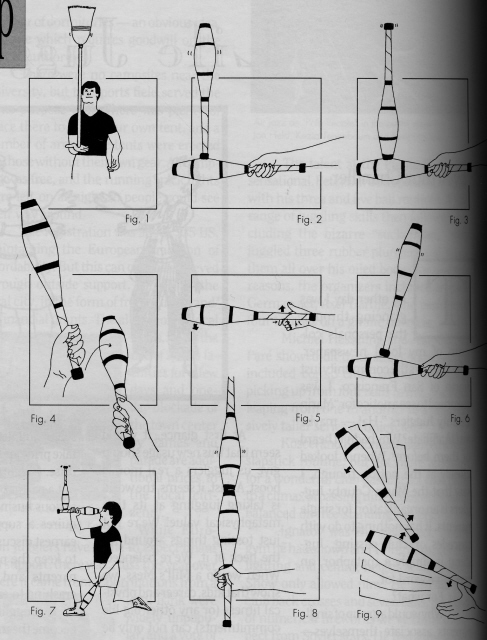 |
Page 28 Winter 1990 - 91
|
JUGGLER'S WORKSHOP Copyright
1990 by Martin Frost & Mike Stillwell
Would
you like to vary the pace of your
routine?
CLUB
BALANCING is the perfect
way to add a dramatic pause to any show. In this issue we'll cover
balancingfor beginners and some real challenges for the more
experienced. Basic Balancing First
let's talk about balancing. Here are two things to remember. 1.
The balance is easiest if you watch the
very top of the object. 2.
Longer objects are easier to balance than
shorter ones. For
initial balancing practice, you can start with a broom. Hold it
vertically with the sweeping end at the top and try to balance the
broom on the palm of your hand (Fig. 1). Remember to look at the
highest part of the broom. That's the part that will move the most if
the balance starts to fail, so you get the best feedback by focusing
there. If you have trouble with this, it's probably because you're not
looking up at the top.
Now try a shorter object. Saw off about a foot of the broom. Each time you shorten the object, the balancing becomes a little harder because you have to react just a little faster to prevent a fall. But each time, your brain will adapt and figure out what to do. You don't have to consciously think, "OK, when it leans this way I move my hand this way." Just practice and it will come (but watch the top). Practice balancing with each hand.
Now,
what we want to do is
to get into a cIub-on-cIub
balance from a regular
cascade. We'll explain two ways. They're
both good but one is fairly easy and the other is fairly
difficult. We'll cover the easy way first. If you are trying the hard
way in a show and you miss, you can always use the easy way as a
backup and probably even get a laugh out of it. The
Easy Way: The Set-Balance The
easy move is called the set-balance because you set one club onto
the other with your hand. We'll break this into a few steps to
make. it easy to learn. Start
by juggling three clubs in a regular cascade. Throw a double spin from
your right hand to your left but for now don't catch it, just let it
fall to the ground. As that club is in the air, take the club you hold
in your left hand and place it onto the one in your right hand (see Fig.
4) and
|
 |